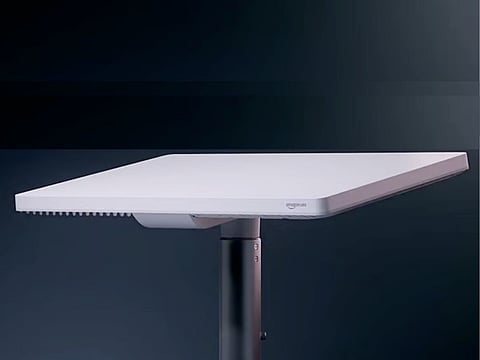You've heard of Elon Musk's Starlink: Now meet Jeff Bezos' Leo, a game-changer with up to 1Gbps?
Amazon Project Kuiper, now rebranded as Leo, could rival Space X internet constellation

A new cosmic showdown between two tech titans has just unfolded.
In the high-stakes race to blanket the planet with high-speed satellite internet, Elon Musk's Starlink (Space X) has long held the crown as the go-to solution for remote connectivity.
But Jeff Bezos' Amazon is never one to sit on the sidelines, now charging into the fray — with its own ambitious contender: the Amazon Leo Ultra.
What's with the name?
It's a nod to the advanced low Earth orbit (LEO) satellite constellation already used by thousands of Starlink satellites.
"Our mission remains the same: to deliver fast, reliable internet to those beyond the reach of existing networks," the company stated in a promo video.
Unveiled recently, the Leo terminal is dubbed as "enterprise-grade" and promises to deliver blazing-fast broadband from low-Earth orbit, positioning Amazon's Project Kuiper (now rebranded as Leo) as a serious rival to Elon Musk's satellite empire.
The announcement highlights the Leo Ultra as a robust, weatherproof powerhouse designed for businesses and heavy users who demand reliability without compromise.
Real-world solution
At its core, the terminal boasts "full-duplex phased array" technology, powered by custom Amazon Leo silicon, ensuring seamless two-way communication with minimal latency.
This isn't just another dish — it's engineered for the real world, complete with an integrated heat sink to handle extreme temperatures.
Dimensions, speed
The Leo customer dish has a compact footprint of 20 inches by 30 inches by 1.9 inches, making pole-mount installations straightforward and unobtrusive.
Performance-wise, Amazon is aiming high.
The Leo Ultra is capable of up to 1 Gbps download speeds and 400 Mbps uploads.
With these figures, Leo could turn itself into a game-changer for data-intensive operations in underserved areas, from rural enterprises to disaster-response teams.
Will those numbers hold everywhere?
While real-world speeds will depend on satellite density and atmospheric conditions.
Price war with Starlink?
But at these specs, Leo (a brainchild of tech billionaire Jeff Bezos) is in direct competition with Starlink's latest offerings.
Could Leo's arrival lead to a price war?
It's an open question, with a potential for price war that would benefit end users, leading to an innovation boom in the satellite broadband market and the areas they serve.
This reveal comes at a pivotal moment for Amazon's space ambitions.
Leo's current constellation
Formerly known as Project Kuiper, the Leo constellation already has 150 satellites in orbit, with initial network testing in full swing.
The company plans to scale up to thousands more in the coming years, but for now, the focus is on proving the tech works.
Pricing
No pricing details have been disclosed yet — leaving consumers and businesses guessing whether affordability will be the Ultra's secret weapon against Starlink's established ecosystem.
Critics might point out the irony: Amazon still relies on SpaceX rockets to launch many of its satellites, underscoring the interconnected web of the space industry. Amazon is also developing its own stable of reusable rockets.
Even if Starlink continues to lead, competition is awesom, even if it doesn't immediately dethrone the leader.
Others are already buzzing about potential ripple effects, like pushing Starlink to boost its upload speeds or refine its user terminal designs.
As 2026 approaches — the targeted launch window for the Leo Ultra — eyes will be on Amazon to deliver not just hardware, but a viable alternative network.
Will Jeff Bezos finally claim a win in the space race, or will Starlink's first-mover advantage prove insurmountable?
One thing's certain: the stars are aligning for faster, more accessible internet from above.
Sign up for the Daily Briefing
Get the latest news and updates straight to your inbox






